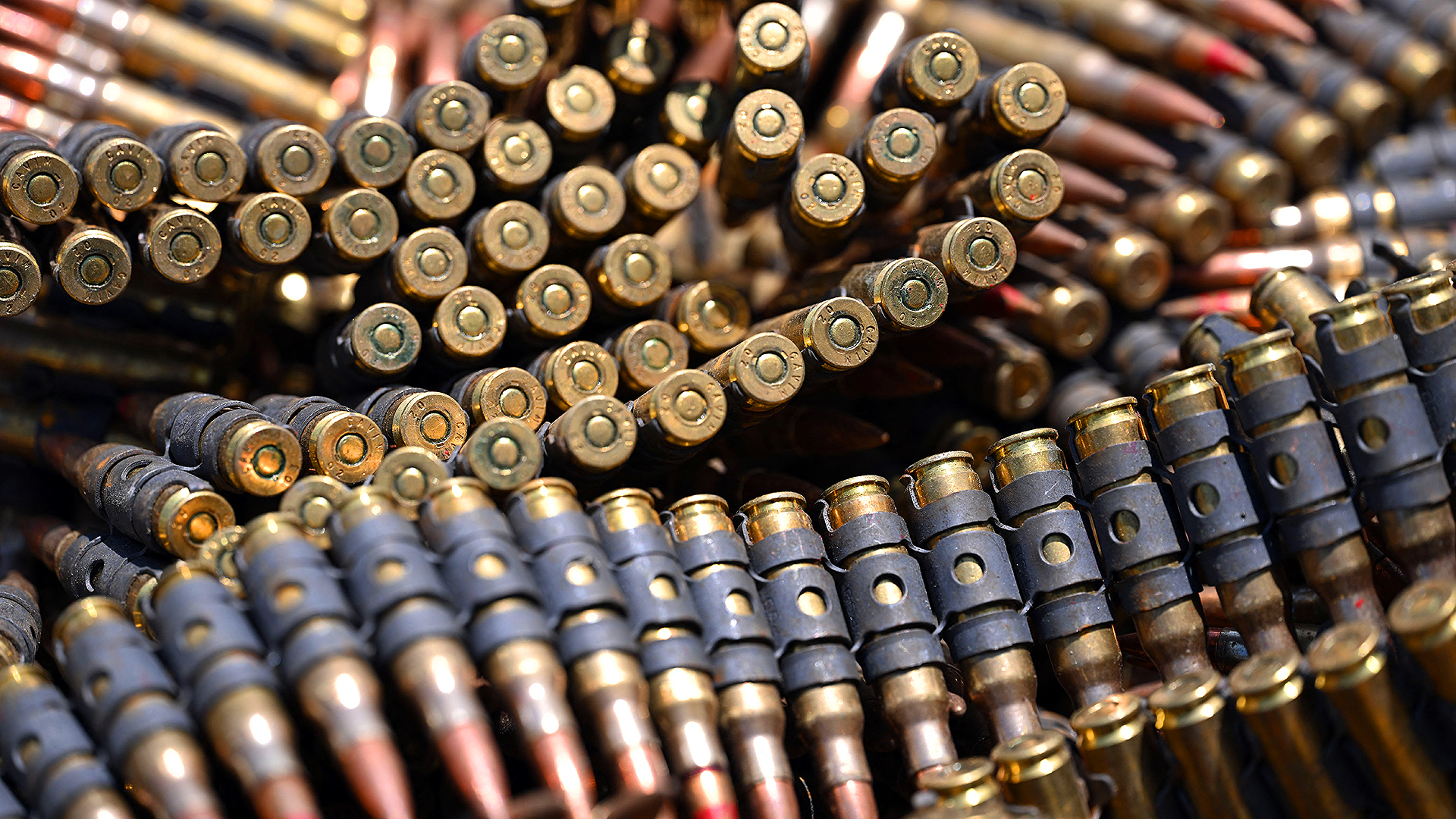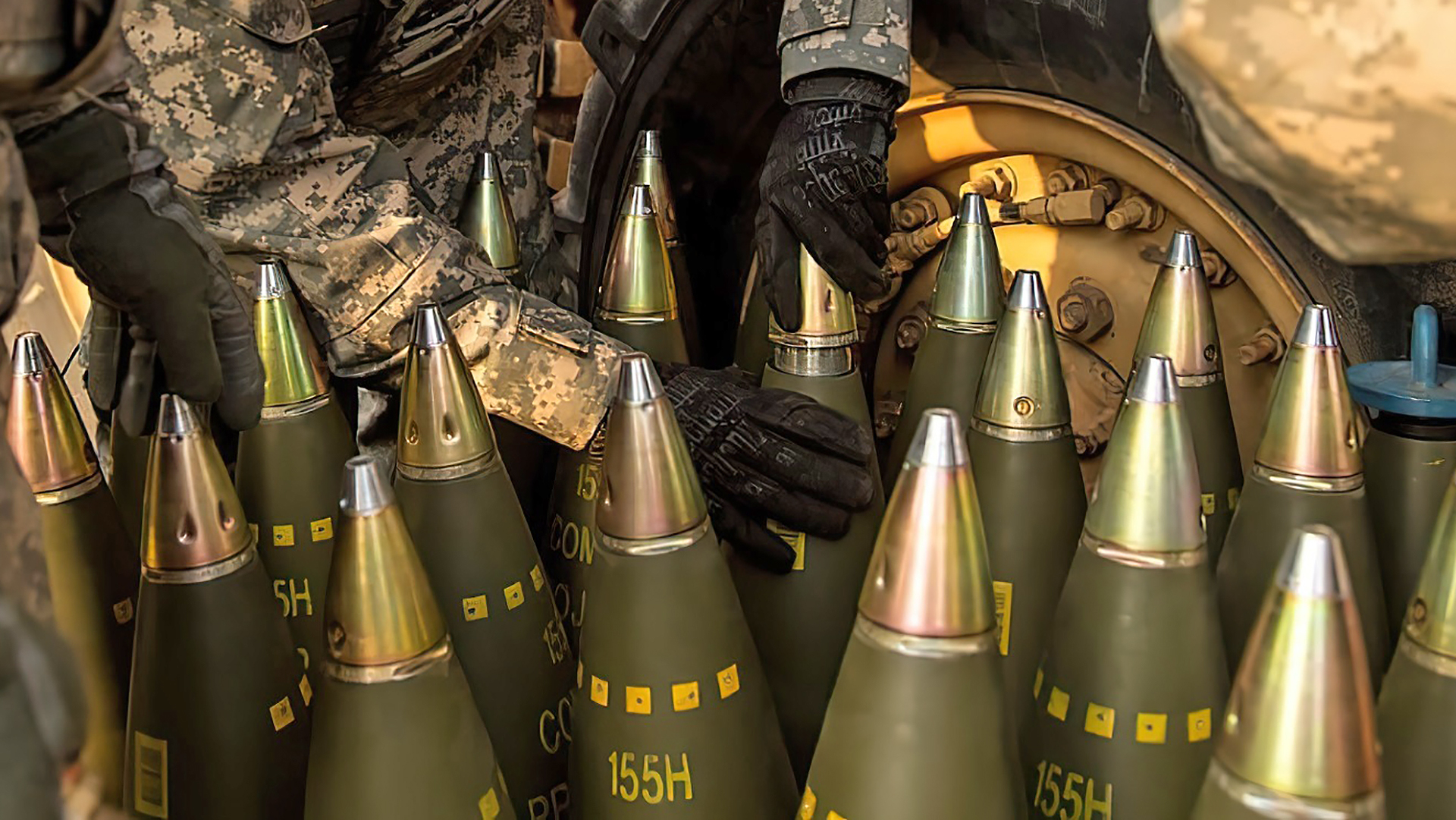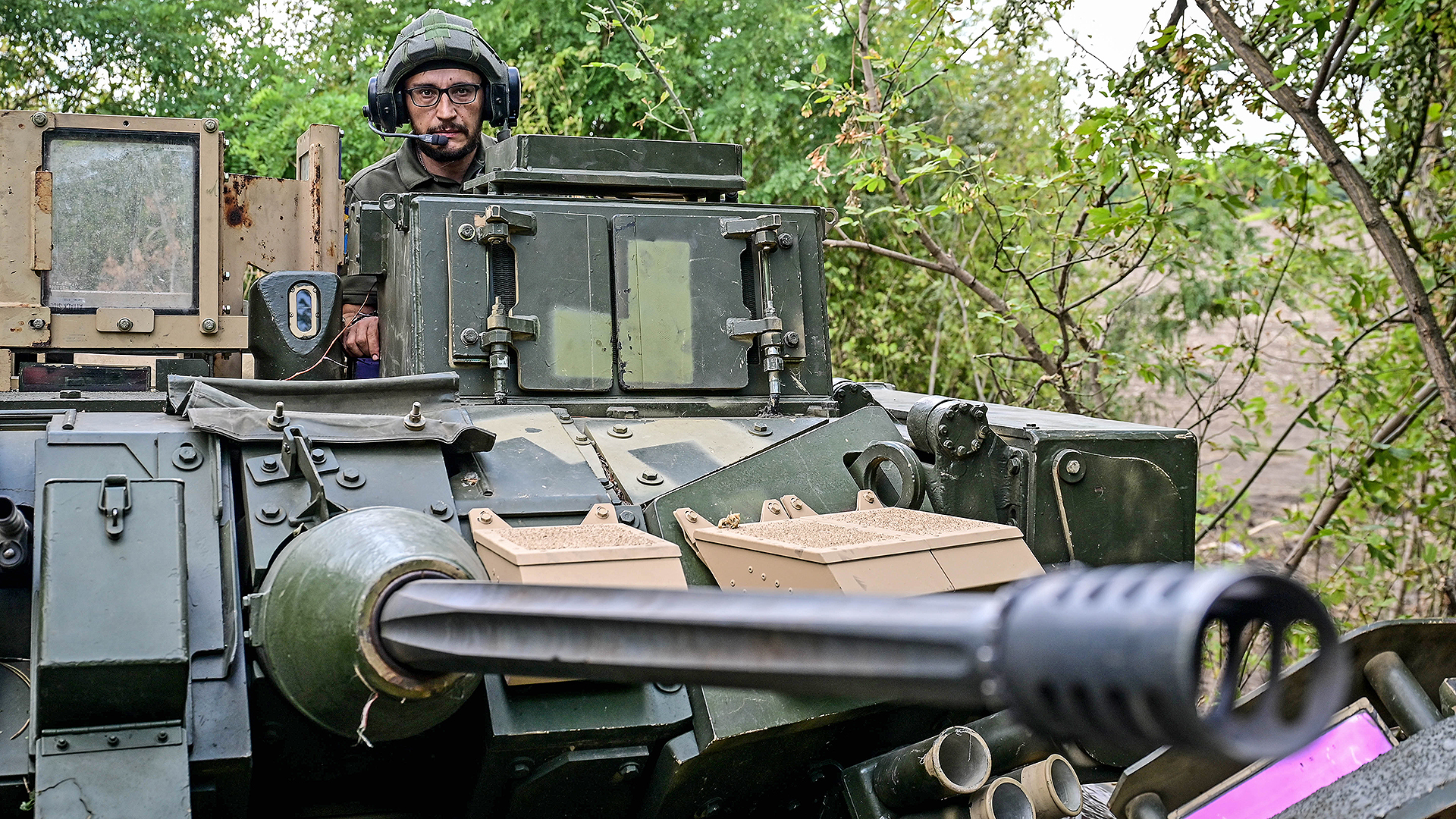As the war drags on, U.S. funding for Ukraine has nearly dried up and military aid, in particular, is now being rationed. That’s because Congress has failed to pass a supplemental aid package, Deputy Pentagon Press Secretary Sabrina Singh told reporters on Thursday.
“It’s incredibly important to talk about Ukraine in the context of the ongoing budget conversations that are happening on the Hill and of course all in the context of funding running out at the end of the week next week,” she said. “We have been forced to meter out our support to Ukraine.”

President Joe Biden had requested a $106 billion aid package to be split between Ukraine and Israel, but also including funds to boost competition with China in the Indo-Pacific, as well as security along the U.S. border with Mexico. Congress has not passed it.
The Pentagon has used up “95% of the initial $62.3 billion that we had in Ukraine supplemental resources,” she said. “We’ve used up all of our [Ukraine Security Initiative] USAI funding. And so we only have $1 billion left in existing resources to backfill US stocks.”
There is a “small amount” of Presidential Drawdown Authority (PDA) funding left, said Singh, who did not offer specifics. On Oct. 31, Air Force Brig. Gen. Pat Ryder, the Pentagon’s top spokesman, said there was “a little more than $5.4 billion in restored PDA authority that remains available for Ukraine.”
As a result of these funding shortfalls, aid packages to Ukraine have been been shrinking, Singh said, adding that the U.S. and allies will still support Kyiv’s fight.
“So we really implore Congress to pass the supplemental request that the president set up sent up so that we can continue to meet Ukraine’s battlefield needs.”
The last aid package, on Nov. 3, was for $125 million. It included an undisclosed amount of 155mm ammunition among other munitions.

Ukraine is also facing a potential aid crunch from the European Union, with Hungary threatening to veto a new package of 50 billion euros ($53.4 billion). An alternative is being considered, Bloomberg reported Thursday, citing unnamed people familiar with the matter.
The plan would involve national guarantees from member states to raise funding in the markets if Budapest blocks the review of the EU’s long-term budget, which includes the Ukraine aid package, the people said.
Hungarian Prime Minister Viktor Orban has opposed including the $53 billion package to finance Ukraine’s recovery in the EU’s budget, which requires unanimous agreement from all 27 member nations to be approved.
Ukraine also took a hit from the new government of Slovakia, which cancelled an aid package to Ukraine, estimated at €40.3 million (about $43 million).
“The new left-populist government of Slovakia, a country neighboring Ukraine that had been one of its staunchest supporters, on Wednesday rejected a proposed package of military aid for Kyiv, fulfilling a campaign promise by Prime Minister Robert Fico to halt assistance in the war against Russia,” The Washington Post reported.
The blocking of the roughly $43 million aid package, which was to include rockets and ammunition, is unlikely to change Ukraine’s battlefield capabilities significantly, the Post noted. But the government’s decision, issued at a cabinet meeting, is a first concrete sign of growing fatigue among Kyiv’s supporters in NATO as Russia’s invasion nears the two-year mark.
Ukraine is getting some help from private citizens, like Oleksandr Tkachenko and Roman Zabolotovskyi, have provided Ukraine with $61 million worth of aid.
Still, that’s a small fraction of what’s needed. With little major progress on the battlefield, and the world’s attention turns toward the ongoing Israel-Hamas fight, these are troubling signs for a nation so heavily reliant on foreign support.
Before getting into the rest of the latest news from Ukraine, The War Zone readers can get caught up with our previous rolling coverage here.
The Latest
On the battlefield, Russia is changing the way it is attacking Avdiivka as it continues trying to surround the Donetsk Oblast town from three sides, according to a Ukrainian National Guard (NGU) spokesman.
Having lost a lot of armor in repeated waves of attacks on the besieged city, and with bad weather setting in, Russia is moving to a more dismounted infantry campaign, Ruslan Muzičuk said on the NGU Facebook page Thursday.
“The Defense Forces repelled more than 10 enemy attacks. In this area, our special purpose units are also carrying out a mission,” said Muzičuk.
Avdiivka is well protected, allowing forces there to keep the Russians at bay, he said.
“First of all, pretty good fortifications, fortification structures and, let’s say, echelonized defense that enables our Defense Forces, despite numerous attacks, to hold this city,” he said.
The fighting has taken an incredible toll on the city, leaving it in ruins.
Though armor could offer Russian troops added protection if they could enter Avdiivka, they have lost so much of it just trying to get there. So Russians have changed their approach. That’s meant an even greater reliance on drones, said Muzičuk
“The use of drones by the enemy has doubled in recent months.”
The increased use of drones by Russia is a concern expressed by Ukrainian troops fighting elsewhere in Donetsk, near Bakhmut
Some Ukrainian drone operators are concerned the advantage they once enjoyed, especially in First Person View (FPV) drones, is eroding there.
“Their drones are always in the air, day and night. We can see they’ve implemented serial production of drones for reconnaissance, surveillance and for strikes,” a 34-year-old drone platoon commander, who introduced himself by the callsign “Komrad,” told Reuters.
While it is hard to assess Russian numerical superiority in FPV drones accurately – and the experiences of the unit near Bakhmut provides only a snapshot of what is happening – Komrad estimated it at around double what Ukraine had on his sector of the front.
Still, help may be on the way. Ukrainian Digital Minister Mykhailo Fedorov told Reuters in September that Ukraine had boosted its overall aerial drone production by more than 100 times in 2023. Another minister said in October Ukraine would be making “dozens of thousands” of drones a month by the end of this year.
Elsewhere on the battlefield, the front lines have remained largely stagnant, with no major territorial gains or losses by either side. Ukraine is continuing its push across the Dnipro River into occupied Kherson Oblast. The objective is to keep building out its bridgehead in the town of Krynky and add additional pressure to Russian forces in that area.
Here are some key takeaways from the latest Institute for the Study of War assessment:
- The Russian military command will likely struggle to redeploy combat-effective reinforcements to respond to ongoing Ukrainian operations in eastern Kherson Oblast while conducting defensive operations in western Zaporizhia Oblast and sustaining other offensive efforts in eastern Ukraine.
- Russian forces have likely launched opportunistic localized offensive operations in the Bakhmut direction and intensified ground attacks near Bakhmut in recent days.
- Russian forces continued offensive operations along the Kupyansk-Svatove-Kreminna line, near Bakhmut, in the Avdiivka direction, west and southwest of Donetsk City, in the Donetsk-Zaporizhia Oblast border area, and in western Zaporizhia Oblast and advanced near Kupyansk.
Ukraine got a much-needed boost Friday to its integrated air defense system with Lithuania donating two National Advanced Surface-to-Air Missiles Systems, or NASAMS.
Ukrainian attacks on Russia’s advanced S-400 air defense system (NATO reporting name SA-21 Growler) will likely force Moscow to reallocate systems from elsewhere, the U.K. Defense Ministry (MoD) said.
After Russia lost several of those systems last week, “new analysis suggests that to maintain coverage over Ukraine, Russia will likely need to reallocate SAMs which are routinely protecting distant parts of Russia,” the MoD said in its most recent assessment.
“Positioned at strategically important locations, as well as along Russia’s borders, removing systems would almost certainly weaken Russia’s air defense posture on its peripheries. The reallocation of strategic air defense assets would further demonstrate how the Ukraine conflict continues to overextend Russia’s military and strains its ability to retain baseline defenses across its vast area.”
That’s similar to an assessment Lt. Gen. Kyrylo Budanov, head of Ukraine’s Defense Intelligence Directorate, shared with us in an exclusive interview in September, when we asked him about the repeated Ukrainian attacks on S-400 systems in Crimea.
“So first of all, the fact itself is that we’re engaging the military infrastructure and military targets in occupied Crimea and the occupier’s infrastructure. If we’re going deeper into strikes against the air defense system, it’s more complicated here,” he told us. “First of all, the air defense systems themselves are very costly equipment and it takes a lot of time to produce those and Russian flags those systems because all this inventory is currently engaged in fighting against Ukraine and also in protection of Moscow. They’ve taken away air defenses from everywhere else.”
This could provide a new opportunity for Ukrainian long-range drone strikes into Russian territory which have slowed to a trickle in recent months.
In another sign of how the war’s effect, Russia wants to retrieve parts from defense systems it had exported to countries such as Pakistan, Egypt, Belarus and Brazil, The Wall Street Journal reported. It’s part of an effort to replenish the enormous stocks of weapons being expended for the war in Ukraine.
Last April, a delegation of Russian officials visiting Cairo asked Egyptian President Abdel Fattah Al Sisi to give back more than a hundred engines from Russian helicopters that Moscow needed for Ukraine, three people with knowledge of the incident told the publication. Sisi agreed and deliveries of about 150 engines are likely to start next month, say the people.
An Egyptian government spokesman declined to comment.
“Russia spent decades building its arms trade,” said a person with knowledge of the buybacks. “Now they’re going back in secret to their customers trying to buy back what they sold them.”
The major lack of supportability among Russian military and aerospace exports due to the war and sanctions is widely known, which has caused some U.S. manufacturers to step in to try to capture that market share.
One of the four M7 Bradley Fire Support Team (BFIST) variants donated by the U.S. was recently spotted in Ukraine, completed with Bradley Reactive Armor Tiles (BRAT).
The U.K. MoD says the international Op Interflex effort to train Ukrainian troops is ahead of schedule, with 30,000 having gone through the program.
As mine fields continue to cause havoc for Ukrainian forces, Kyiv got some good news in the form of the Swiss Global Clearance Solutions company opening up a service center for its GCS-200 and GCS-100 unmanned demining vehicles.
The Soviet-era BM-21 Grad multiple launch rocket system (MLRS) remains a fearsome weapon for both sides. This video below shows it in use by Ukraine, lighting up the night sky as rockets fly toward Russian positions.
The war continues to take a toll on Ukraine’s ecology. The Dzharylhach National Park, for instance, was completely destroyed, according to Ukraine’s Ministry of Ecology.
Kyiv residents are not letting air raid alerts get in the way of recreation. This video below shows children playing soccer in a Kyiv metro during one such recent event.
That Ukrainian pilots have begun training on F-16s was met with typical humor by a nation adept at information operations.
And finally, a young boy is helping with the rehabilitation of his father, who lost both hands fighting the Russians.
That’s it for now. We’ll update this story when there’s more news to report about Ukraine.
Contact the author: howard@thewarzone.com

